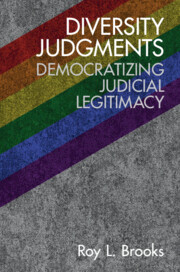Book contents
- Diversity Judgments
- Diversity Judgments
- Copyright page
- Dedication
- Contents
- Preface
- Acknowledgments
- Introduction
- Part I Asian Americans
- 1 Matal v. Tam (Trademarking Racial Slurs)
- 2 Lau v. Nichols (Bilingual Education)
- Part II African Americans
- Part III Women
- Part IV Latinx
- Part V Native Americans
- Part VI LGBTQ
- Part VII Intersectionality
- Part VIII Outsiders v. Outsiders
- Part IX White Males
- Part X Situational Outsiders
- Index
1 - Matal v. Tam (Trademarking Racial Slurs)
from Part I - Asian Americans
Published online by Cambridge University Press: 10 March 2022
- Diversity Judgments
- Diversity Judgments
- Copyright page
- Dedication
- Contents
- Preface
- Acknowledgments
- Introduction
- Part I Asian Americans
- 1 Matal v. Tam (Trademarking Racial Slurs)
- 2 Lau v. Nichols (Bilingual Education)
- Part II African Americans
- Part III Women
- Part IV Latinx
- Part V Native Americans
- Part VI LGBTQ
- Part VII Intersectionality
- Part VIII Outsiders v. Outsiders
- Part IX White Males
- Part X Situational Outsiders
- Index
Summary
A trademark is an ancient concept. It is a symbol or word used to represent or distinguish one’s brand. Roman blacksmiths often inscribed their initials or symbols into the handles of swords to identify the weapon’s maker. Soldiers looked for these trademarks to differentiate among the quality of swords being sold. Thus, a trademark is a kind of property right. The user or holder of the mark owns an enforceable right to the goodwill built into it.
- Type
- Chapter
- Information
- Diversity JudgmentsDemocratizing Judicial Legitimacy, pp. 53 - 83Publisher: Cambridge University PressPrint publication year: 2022

